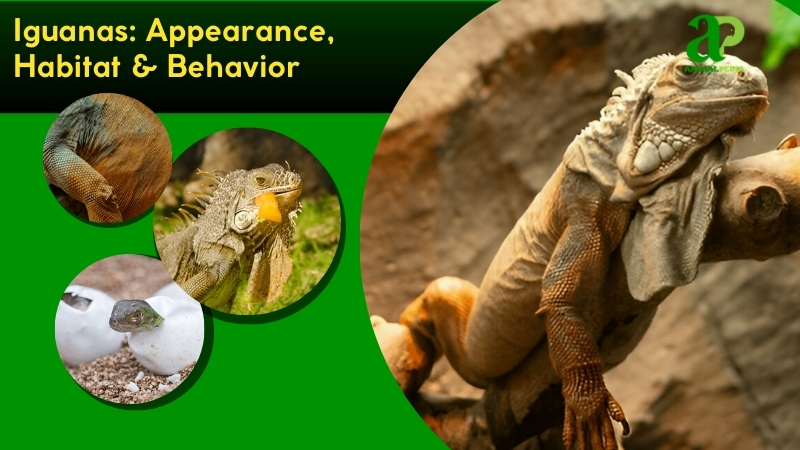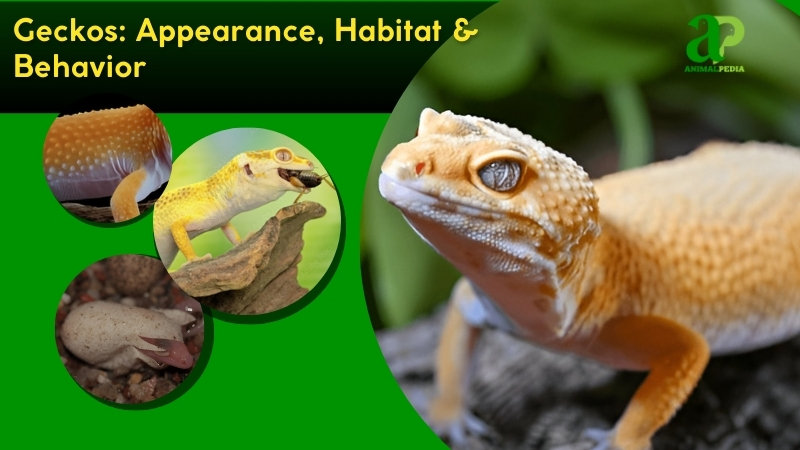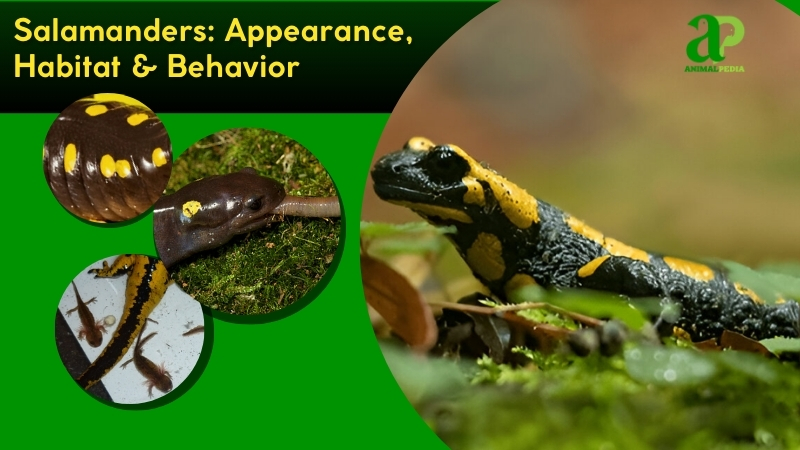Python snakes boast sleek, muscular bodies with vivid patterns across roughly 40 species. Their scales gleam in browns, greens, or golds, featuring diamond or blotched designs. These non-venomous constrictors, including the reticulated python, reach impressive lengths of 20-33 ft (6-10 m), demonstrating their formidable power.
Key species include Python reticulatus (reticulated python) and Python molurus (Indian python). Reticulated pythons, the world’s longest serpents, dominate Southeast Asian rainforests. The stockier Indian pythons thrive in Indian grasslands, recognizable by their bold markings.
Their range spans Southeast Asia, Indonesian islands (Sumatra, Borneo, Java), the Indian subcontinent, and northern Australia. Heat-sensing labial pits, unique anatomical features of pythons, detect warm-blooded prey with remarkable accuracy.
While not apex predators, pythons excel as ambush hunters. They coil around prey and squeeze until suffocation occurs. Their diet consists mainly of medium-sized vertebrates. Pythons rarely attack humans unless threatened, according to Shine’s 2017 research.
Breeding behavior occurs from October through December during rainy seasons. Females deposit 20-100 eggs and coil protectively around them for 60-80 days. Hatchlings measuring 60-90 cm hunt rodents initially and reach maturity in 3-5 years. Their lifespan typically ranges from 20-30 years, with captive specimens often living longer.
This article examines pythons’ distinctive appearance, habitat diversity, and hunting strategies, emphasizing their ecological importance in tropical ecosystems.
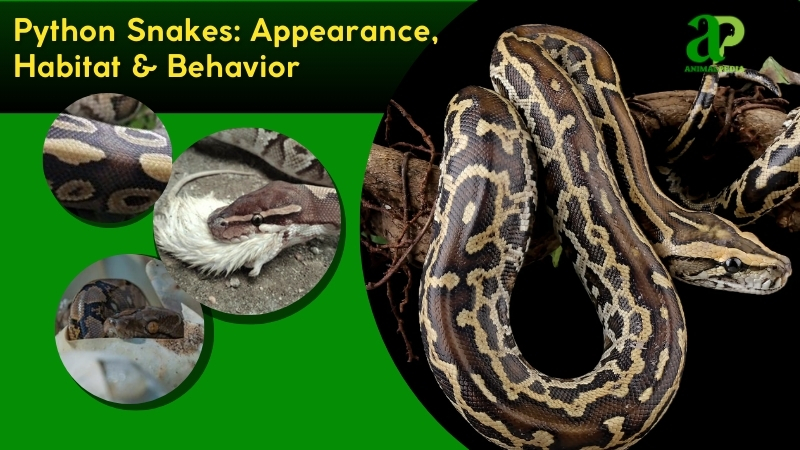
What do the Python snakes look like?
Python snakes have long, muscular bodies, stretching 4-10 meters (13-33 feet), with smooth, glossy scales. Their coloration ranges from brown and olive to golden, often featuring diamond patterns or net-like markings. Their slick skin helps them move efficiently through dense jungle terrain.

Key anatomical features include a broad, triangular head with heat-sensing pits; small, piercing eyes; a forked tongue for chemosensory detection; no distinct neck; a thick, sinuous body; complete absence of limbs; and a tapering tail for balance and stability.
Unlike boas, pythons possess labial pits for infrared prey detection, a characteristic not found in vipers. The Reticulated python (Python reticulatus) displays intricate geometric patterns, while the Indian python (Python molurus) exhibits bolder blotches with higher contrast, as documented in Shine’s comprehensive ophidian research (2017).
How big do Python snakes get?
Pythons average 13–20 ft (4–6 m) in length and weigh 110–220 lbs (50–100 kg). Adult reticulated pythons (Python reticulatus) typically reach 20–26 ft (6–8 m) from snout to tail.

The longest recorded python, found in Malaysia, measured 33 ft (10 m) and weighed 440 lbs (200 kg), according to Shine et al. (2017). Females grow longer and heavier than males, often by 3–6 ft (1–2 m).
| Trait | Male | Female |
| Length | 13–20 ft (4–6 m) | 16–26 ft (5–8 m) |
| Weight | 110–176 lbs (50–80 kg) | 154–264 lbs (70–120 kg) |
What are the unique physical characteristics of the Species?
Python snakes have heat-sensing pits along their lips. These thermoreceptor organs detect infrared radiation from warm-blooded prey. Unlike boas or vipers, this feature belongs only to pythons. The pits work with remarkable precision at night.
Shine’s research (2017) reveals these upper jaw thermoreceptors respond to temperature changes as small as 0.002°C. This sensitivity allows species like the Python reticulatus (reticulated python) to strike with accuracy in complete darkness, giving them an evolutionary advantage in diverse habitats.
Their parietal eye represents another distinctive trait. This specialized photoreceptor sits atop the head. While it cannot form images, this “third eye” detects light variations and movement, helping pythons avoid predators and maintain circadian rhythms (Lopez et al., 2020). Connected to the pineal gland, this organ plays a crucial role in thermoregulation and seasonal behavioral patterns.
How do Python snakes sense their environment with its unique features?
Python snakes navigate their world through remarkable sensory systems. Heat-sensing pits along their upper jaws detect infrared radiation from warm-blooded prey in total darkness. This thermoreception gives these constrictors a decisive hunting advantage in dense forests and underground burrows (Grace et al., 2019).
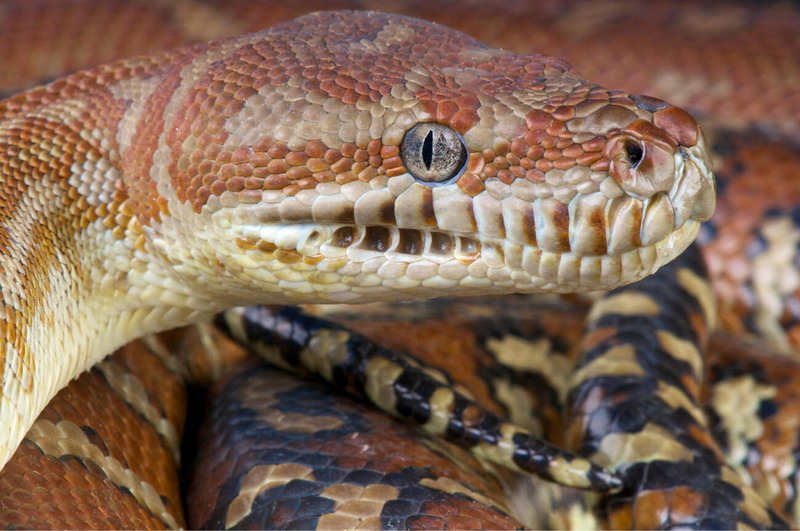
Their vision specializes in movement detection rather than fine detail—perfect for ambush hunting strategies. The highly developed Jacobson’s organ processes chemical cues, enabling pythons to track prey and potential mates through chemosensory perception. Tactile receptors in their scales detect subtle vibrations, alerting them to nearby organisms or threats.
Despite lacking external ears, pythons possess mechanoreception capabilities, sensing ground-borne vibrations that signal movement nearby. This integrated sensory network creates a comprehensive environmental awareness that has made these ophidian predators successful hunters across diverse habitats.
Anatomy
Python snakes’ internal anatomy is intricately adapted to their role as apex ambush predators. Each organ system works synergistically to support their ability to locate, subdue, and digest large prey in diverse environments, from dense rainforests to arid savannas.
- Respiratory System: Single functional lung maximizes air intake, aiding prolonged constriction during hunting.
- Circulatory System: Three-chambered heart pumps efficiently, sustaining energy for capturing large prey.
- Digestive System: Expandable jaws and acidic stomach digest whole animals, bones included.
- Excretory System: Kidneys expel uric acid, conserving water in humid jungle habitats.
- Nervous System: Advanced brain and heat-sensing nerves ensure precise strikes in darkness.
Together, these physiological adaptations enable pythons to thrive in varied ecosystems. Their anatomical specializations optimize energy efficiency, stealth, and survival—crucial for species that rely on ambush tactics and infrequent, but massive, meals.
How many types of Python snakes?
Python snakes include about 40 species within the family Pythonidae. Classification relies on the Linnaean system, established by Carl Linnaeus, using morphology and molecular genetics.
The taxonomy branches as: Order Squamata → Family Pythonidae → Genera → Species.
Order Squamata
└── Family Pythonidae
├── Genus Python (e.g., P. reticulatus)
└── Genus Morelia (e.g., M. viridis)
Special cases involve disputed species like Python kyaiktiyo, with uncertain genetic distinction, per Reynolds et al. (2016).
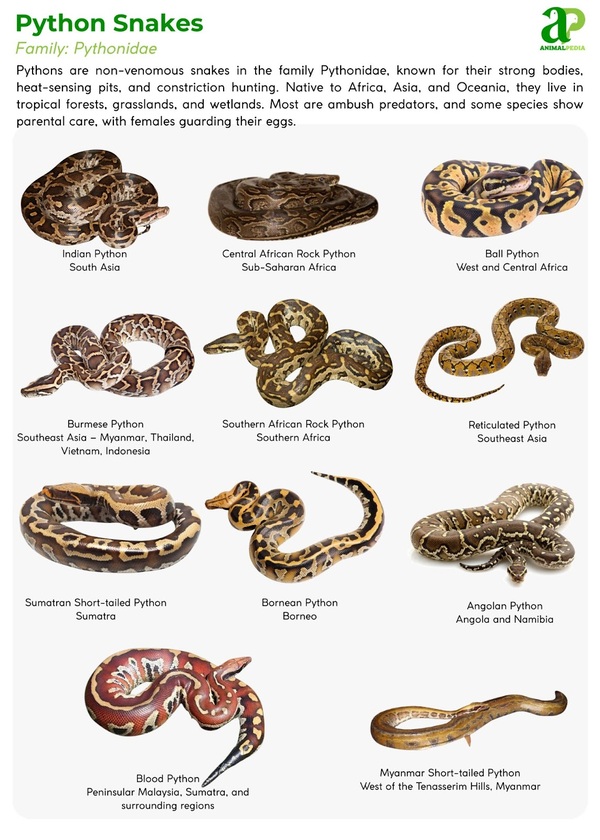
Where do Python snakes live?
Python snakes live across Southeast Asia, Indonesia (Sumatra, Borneo, Java), India, and northern Australia. Reticulated pythons thrive in Malaysia’s rainforests, the swamp-dwelling Blood Python is found in Sumatra, and Indian pythons dominate grasslands across the subcontinent.

These constrictors prefer humid, warm habitats that support their cold-blooded physiology. Dense vegetation and water sources enhance their ambush-hunting strategy. They wait motionless for prey—sometimes for days. Burmese pythons and African rock pythons show remarkable adaptability, occupying both ground and tree environments within their range.
Fossil records show pythons have inhabited these same regions for 15 million years without significant migration patterns, according to Shine’s comprehensive 2017 research on python biogeography.
How do seasonal changes affect their behavior?
Python snakes, as ectothermic reptiles, synchronize their biological rhythms with seasonal environmental changes, especially in tropical ecosystems where they are native. Their behavior, reproduction, and hunting patterns are heavily influenced by the region’s dual-season climate cycle.
- Wet Season (May–October): Increased prey spurs hunting; mating peaks with males actively seeking receptive females.
- Dry Season (November–April): Reduced food availability slows activity; females retreat to secure, thermally stable burrows to lay eggs, conserving energy for brooding.
These seasonal adaptations enhance survival and reproductive success. By aligning their physiological and behavioral strategies with predictable climatic shifts, pythons optimize energy use and ensure offspring development in stable microhabitats.
What is the behavior of Python snakes?
Python snakes are among the most efficient ambush predators in the reptile world. Their behaviors are finely tuned to solitary survival and silent predation, shaped by evolutionary adaptations across diverse ecosystems.
- Feeding Habits: Ambush predators constrict prey like mammals. They swallow whole after squeezing.
- Bite & Venomous: Non-venomous, their bite grips prey. For questions such as ‘Do python snakes have teeth?’, yes, they do. But they use their teeth only to hook the prey, not to poison them.
- Daily Routines and Movements: Nocturnal, they move 1–2 km nightly. Rest in trees or burrows.
- Locomotion: Slither using belly scales for grip. Swim short distances adeptly.
- Social Structures: Solitary, except during mating. Males compete for females briefly.
- Communication: Use tongue flicks and body postures. Hiss to deter threats.
These behavioral traits not only support survival in dense forests, grasslands, and wetlands, but also highlight the python’s role as a dominant ecological regulator in its food chain.
What do Python snakes eat?
Pythons are obligate carnivores with diets shaped by body size, age, and seasonal prey availability. Their ambush strategy and powerful constriction make them apex predators in many tropical ecosystems.
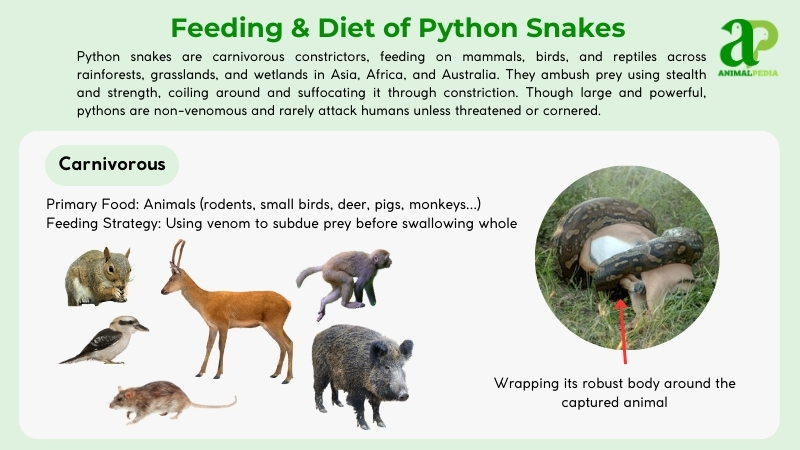
- Diet by Age
Hatchlings feed primarily on small mammals such as mice, rats, and birds. This manageable prey size supports early growth and energy needs. Juveniles progress to slightly larger animals, including squirrels and small lizards, as their jaw flexibility and strength increase. Meanwhile, adults are capable of subduing larger prey like wild pigs, deer, monkeys, and occasionally domestic animals like goats and poultry.
- Diet by Gender
Males and females consume similar prey types, though females, being generally larger, can overpower and ingest heavier prey. No behavioral difference in hunting methods is observed between genders, but females may require larger caloric intake, especially during the breeding cycle.
- Diet by Seasons
During wet seasons (May–October), prey abundance increases, prompting frequent hunts. In dry seasons (November–April), prey scarcity slows feeding rates, and pythons may fast for weeks or months.
How do Python snakes hunt their prey?
Python snakes hunt with deadly efficiency in the wild. They combine stealth, patience, and a powerful sense of smell to capture prey. These constrictors remain motionless, blending into their environment until the perfect moment arrives. Their specialized heat-sensing pits detect warm-blooded animals even in total darkness.
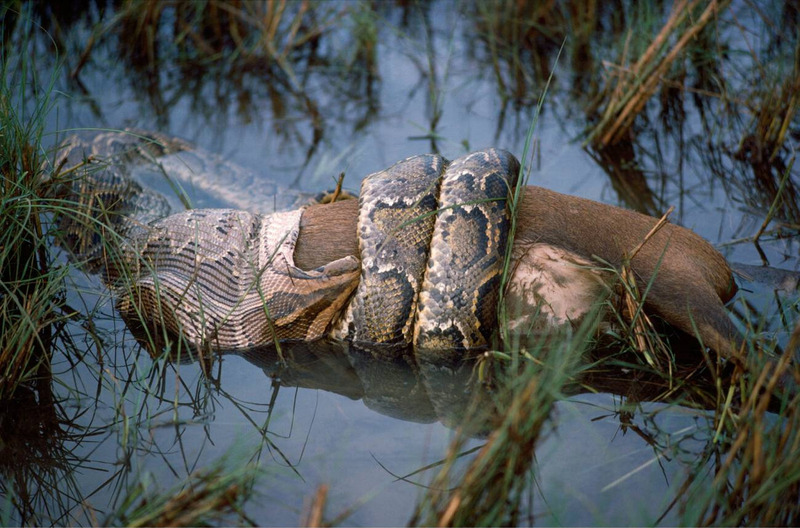
When the target comes within range, the python strikes with remarkable speed. It seizes prey with backward-curving teeth, then rapidly coils its muscular body around the victim. The constriction technique doesn’t crush but prevents breathing—each time the prey exhales, the python tightens its grip until suffocation occurs.
The diet of these ambush predators varies widely. Pythons consume rodents, birds, and sometimes larger mammals like deer or antelope, depending on the species and size. Their hunting strategy demonstrates remarkable evolutionary adaptation. A python’s predatory behavior represents nature’s efficiency—no wasted motion, no unnecessary energy expenditure.
Are Python snakes venomous?
The Python snake is not venomous. It is a formidable predator, relying on its strength and technique to catch its prey. Unlike venomous snakes, Pythons don’t use venom for hunting. Instead, they use their powerful coils to constrict their victims.
So, do Python snakes bite? Yes, they do. When a Python strikes, it bites down on its prey and then wraps its body around them, squeezing tightly until the prey is subdued. This method, though intense, is a natural way for Pythons to survive and thrive in their environment.
Pythons are skilled hunters, leveraging their muscular bodies to overpower their prey. Their lack of venom sets them apart in the animal kingdom, showcasing their unique hunting strategy.
While they may not use venom, Pythons are just as effective and fearsome as predators. With their incredible hunting abilities, these creatures are truly remarkable in the wild.
When are Python snakes most active during the day?
Python snakes are most active during dawn and dusk. These crepuscular reptiles hunt during these twilight hours when visibility favors their ambush strategy. Their specialized heat-sensing pits detect warm-blooded prey with remarkable precision during these low-light conditions.
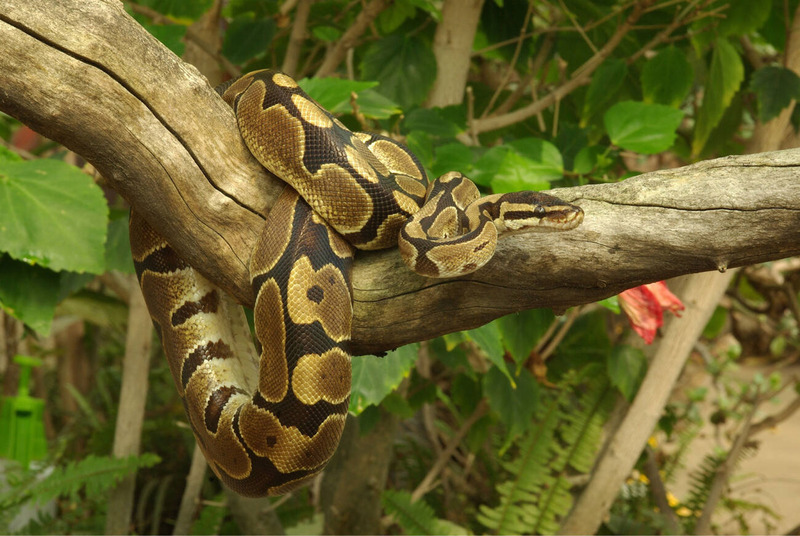
In cooler weather, ball pythons, reticulated pythons, and other python species may extend their activity into daylight hours. They often thermoregulate by basking in patches of sunlight to reach optimal body temperature before resuming hunting activities.
The ambush predator behavior of pythons is highly efficient. They remain motionless, sometimes for hours, before striking with explosive speed. This energy-conserving hunting technique serves them well in their natural habitats across Africa, Asia, and Australia.
Their muscular bodies and stealth movement make pythons formidable hunters during these active periods. Their exceptional constriction ability allows them to subdue prey much larger than their head size – a key evolutionary advantage in their ecological niche.
How do Python snakes move on land and water?
Python snakes have remarkable movement capabilities both on land and in water. These creatures gracefully navigate diverse terrains with agility and finesse. When moving on land, pythons utilize their robust muscles to propel themselves forward in a distinctive serpentine manner. In addition to slithering, they can also climb trees and swim effortlessly in water.

On land, Python snakes employ a fascinating technique known as “rectilinear movement,” allowing them to travel in a straight line by contracting and expanding their muscles along their bodies.
In the water, Pythons showcase impressive swimming skills, using a wave-like motion to glide smoothly through aquatic environments such as lakes and rivers. This versatile movement enables them to hunt for food and find resting spots with ease.
The mesmerizing elegance displayed by Pythons in their movement highlights their adaptability and strength as formidable predators in their natural habitats, both on land and in the water. Their ability to navigate different environments effectively contributes to their success in the wild.
Do Python snakes live alone or in groups?
Python snakes are solitary creatures, preferring to live and hunt alone in their natural habitats. Their independent behavior allows them to move freely without the constraints of group dynamics. These majestic snakes rely on ambush tactics and stealth to catch their prey, focusing solely on their hunt without the need for coordination with others.
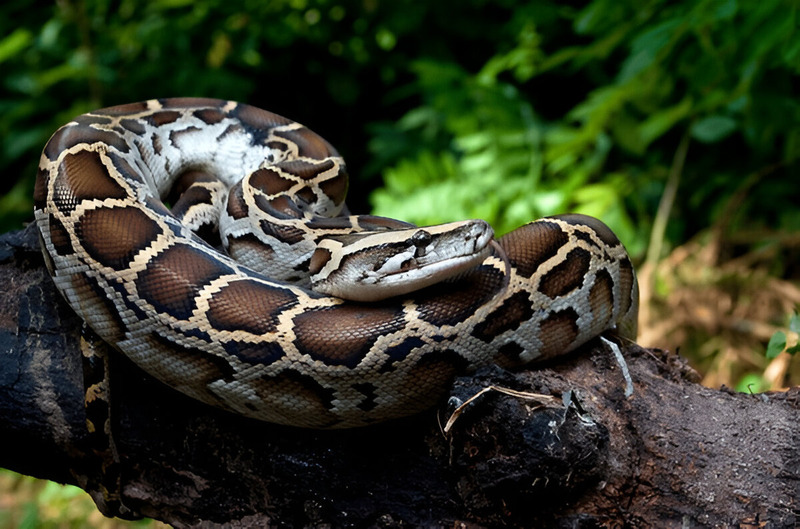
Living alone also means that Python snakes establish and fiercely defend their territories against intruders. These territories provide them with a sense of security and a reliable food source, ensuring their survival in the wild.
So, while they may roam the dense vegetation solo, Python snakes are well-equipped to thrive independently in their surroundings.
It’s fascinating to see how these creatures navigate and thrive in their solitary lifestyles, showcasing their adaptability and hunting prowess in the wilderness.
How do Python snakes communicate with each other?
Python snakes rely heavily on non-verbal cues to communicate in their world of solitary pursuits and territorial conquests. These reptiles use various methods to convey messages and establish dominance. Through body language, such as posturing and flicking their tongues to gather chemical information from the air, Pythons can signal their intentions without making a sound.
When encountering a rival or potential mate, they may engage in gentle nudges or more aggressive physical interactions to assert their presence and status.
Additionally, Python snakes leave scent trails through pheromones to convey information about their identity, reproductive state, and territory boundaries to others nearby. By interpreting these olfactory signals, Python snakes can identify competitors, threats, or potential mates.
Through these subtle means of communication, Pythons navigate their habitat with precision and ensure successful interactions with their fellow serpents.
How do Python snakes reproduce?
Pythons reproduce oviparously, laying eggs. Breeding begins in the wet season, May to July. Males trail females, flicking tongues; females coil, signaling readiness. Mating lasts hours in dense cover.
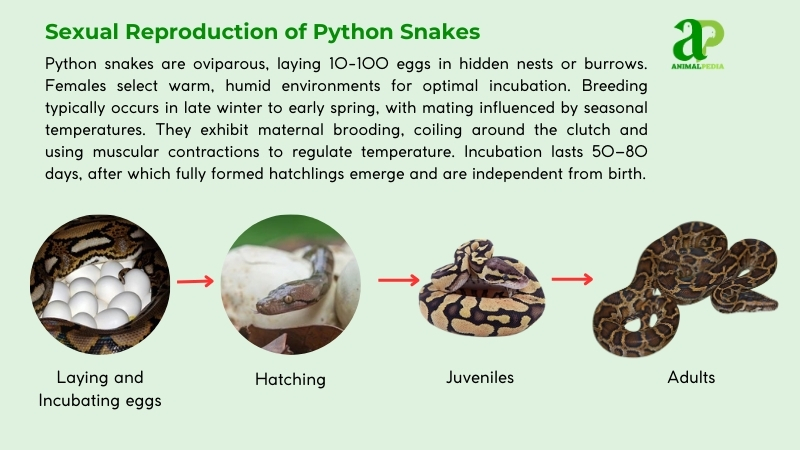
Females lay 20-100 eggs, averaging 100-150 grams each, in humid burrows or leaf piles. They coil around eggs, shivering for warmth, offering no further protection. Males depart; females stay until hatching. Habitat disturbance, like 2018 Borneo floods, can disrupt laying, per Shine et al. (2017).
Eggs hatch in 60-80 days. Hatchlings, 60-90 cm, hunt small rodents, growing 1-2 m yearly. They mature in 3-5 years.
Life cycle spans 20-30 years. Reticulated pythons (Python reticulatus) often outlive others due to robust habitats.
How long do Python Snakes live?
Python snakes live 20 to 30 years in captivity, with Ball Pythons (Python regius) often exceeding 30 years under optimal care. In the wild, these constrictors typically survive 15 to 20 years due to predators, disease, and environmental challenges.
Male and female pythons share similar lifespans with no significant gender differences. Larger species like the Reticulated Python (Malayopython reticulatus) may live longer because their size deters predators. The lifecycle progresses through distinct phases: egg incubation, hatchling, juvenile, subadult, and mature adult stages.
What are the threats or predators that Python snakes face today?
Python snakes, though apex predators in many ecosystems, still face a variety of natural and anthropogenic threats. Their populations are increasingly influenced by environmental changes, human activity, and interspecies dynamics.
- Habitat Loss: Rapid deforestation and land-use conversion for agriculture and urban development have fragmented tropical forests, particularly in Southeast Asia and sub-Saharan Africa. This limits suitable shelter and hunting grounds, reducing reproductive success.
- Illegal Wildlife Trade: Pythons are heavily hunted for their skin, meat, and for the exotic pet trade. This has led to severe population declines, especially for the reticulated python (Malayopython reticulatus) and Burmese python (Python bivittatus) (Nijman et al., 2018).
- Climate Change: Shifting rainfall patterns and rising temperatures alter prey availability and affect nesting success. Prolonged droughts during dry seasons reduce access to water and food sources.

Humans are the primary threat to python populations. Overexploitation for commercial use and habitat encroachment continue to shrink viable populations in the wild.
Are Python snakes endangered?
Python snake conservation status varies by species. Some face serious threats while others maintain stable populations.
The Burmese python (Python bivittatus) is classified as “Vulnerable” on the IUCN Red List. These serpents face declining numbers due to habitat destruction, illegal wildlife trafficking, and overharvesting for their skin and the exotic pet trade (IUCN, 2021). Their populations continue to drop across native Southeast Asian habitats, particularly in Myanmar and Thailand.
The Indian python (Python molurus) holds “Near Threatened” status. These constrictors now exist in fragmented populations throughout South Asia. Despite protection under CITES Appendix I, illegal poaching persists, threatening their survival.
In contrast, the reticulated python (Malayopython reticulatus) remains in the “Least Concern” category. However, these massive snakes still face localized threats from hunting pressure and habitat encroachment in parts of their range.
Field studies show declining wild populations of larger python species due to human impacts (Marshall et al., 2020). Conservation biologists emphasize that habitat preservation and strict trade regulation remain essential to prevent further population collapse of these reptiles.
What conservation efforts are underway?
Habitat protection and anti-trafficking measures form the backbone of conservation for python species, particularly the Indian python (Python molurus). Since 2015, the Wildlife Institute of India has deployed radio telemetry to track python movements and map critical habitats. This ecological data guides the establishment of protected zones across diverse Indian ecosystems.
Legal frameworks provide essential safeguards. The Indian Wildlife Protection Act (1972, amended 2016) classifies pythons under Schedule I, offering maximum protection and prohibiting hunting or trade. Internationally, the CITES Appendix II listing restricts exports through global enforcement mechanisms implemented since 2017.
Ex-situ conservation contributes significantly to recovery efforts. Institutions like Chennai Snake Park have reintroduced over 150 captive-bred hatchlings between 2018-2023. These programs prioritize genetic diversity to ensure robust wild populations (Krishna et al., 2020).
Key stakeholders include the Wildlife Institute of India, IUCN Reptile Specialist Group, and WWF-India. These organizations conduct population surveys, habitat monitoring, and community outreach to minimize human-wildlife conflict.
Results show promise. After wetland restoration, Keoladeo National Park documented a 30% increase in python numbers from 2016-2021. In Assam, community patrol units reduced poaching by 40%, helping stabilize regional populations (Krishna et al., 2020).
The integration of ecological research, legislative protection, and community engagement supports the survival of python species within their native ranges.
Frequently Asked Questions
Can Python Snakes Be Kept as Pets?
You can keep python snakes as pets if you’re prepared for the commitment. They require proper care, space, and knowledge to thrive. Remember, they can grow large and have specific needs, so research before adopting one.
What Is the Lifespan of Python Snakes?
Pythons have a long lifespan, often living for over 20 years in captivity. It is important to provide proper care, including appropriate housing, diet, and regular veterinary check-ups to safeguard your python’s health and well-being.
Do Python Snakes Have Any Social Behavior?
Yes, they do! Python snakes exhibit social behavior, forming loose groups for mating or basking in the sun. These gatherings are more about practicality than companionship. They enjoy some time together but prefer solitude.
Are Python Snakes Endangered Species?
No, python snakes are not considered endangered species. Their populations vary based on factors like habitat loss and illegal wildlife trade. By staying informed and advocating for conservation efforts, you can help protect these magnificent creatures.
Do Python Snakes Make Good Hunters?
You should know that python snakes make excellent hunters. They use their strong bodies and sharp teeth to catch prey efficiently. With their keen senses, they track down food effectively, showcasing their impressive hunting skills.
Conclusion
Python snakes stand as remarkable reptiles with striking diversity in their dimensions, vibrant scale patterns, and specialized hunting strategies. These constrictors flourish across varied ecosystems, exhibiting clear territorial demarcation and exceptional predatory skills without relying on venom. Despite challenges from natural adversaries, pythons demonstrate impressive evolutionary resilience and adaptive capabilities. Their distinctive morphological features, behavioral patterns, and environmental adaptability position them as significant subjects for herpetological research and conservation efforts in their natural habitats.





